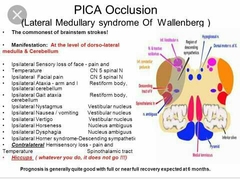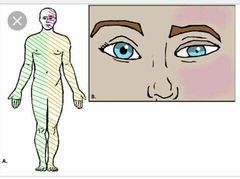![]()
![]()
![]()
Use LEFT and RIGHT arrow keys to navigate between flashcards;
Use UP and DOWN arrow keys to flip the card;
H to show hint;
A reads text to speech;
14 Cards in this Set
- Front
- Back
- 3rd side (hint)
|
Q7 |
disability can be avoided or minimized if evaluation and treatment are rapid. |
|
|
|
Q6 |
Spinal cord disorders usually result from conditions extrinsic to the cord, such as the following:•Compression due to spinal stenosis•Herniated disk•Tumor•Abscess•Hematoma
|
|
|
|
Intrinsic causes are uncommon. What are they |
spinal cord infarction, hemorrhage , transverse myelitis, HIV infection, poliovirus infection, West Nile virus infection, syphilis (which can cause tabes dorsalis), trauma, vitamin B12 deficiency (which causes subacute combined degeneration), decompression sickness, lightning injury (which can cause keraunoparalysis [transient paralysis and sensory deficits with ischemia]), radiation therapy (which can cause myelopathy), syrinx, and spinal cord tumor. Arteriovenous malformations may be extrinsic or intrinsic. Copper deficiency may result in myelopathy similar to that caused by vitamin B12 deficiency. |
|
|
|
Q5 |
The spinal cord extends caudally from the medulla at the foramen magnum and terminates at the upper lumbar vertebrae, usually between L1 and L2, where it forms the conus medullaris. |
|
|
|
Q4 |
The white matter at the cord’s periphery contains ascending and descending tracts of myelinated sensory and motor nerve fibers. |

|
|
|
Q3 |
The central H-shaped gray matter is composed of cell bodies and nonmyelinated fibers .
The gray matter also contains many internuncial neurons that carry motor, sensory, or reflex impulses from dorsal to ventral nerve roots, from one side of the cord to the other, or from one level of the cord to another. The anterior (ventral) horns of the “H” contain lower motor neurons, which receive impulses from the motor cortex via the descending corticospinal tracts and, at the local level, from internuncial neurons and afferent fibers from muscle spindles. |
|
|
|
Q2 |
The posterior (dorsal) horns contain sensory fibers that originate in cell bodies in the dorsal root ganglia. |
|
|
|
Q1 |
The spinothalamic tract transmits pain and temperature sensation contralaterally in the spinal cord; most other tracts transmit information ipsilaterally. most other tracts transmit information ipsilaterally. |
|
|
|
Q |
The cord is divided into functional segments (levels) corresponding approximately to the attachments of the 31 pairs of spinal nerve roots. |
|
|
|
What are the principals of Symptoms and Signs |
Neurologic dysfunction due to spinal cord disorders occurs at the involved spinal cord segment and at all segments below it. The exception is the central cord syndrome which may spare segments below. Disorders affecting spinal nerves, but not directly affecting the cord, cause sensory or motor abnormalities or both only in the areas supplied by the affected spinal nerves. |
|
|
|
Spinal cord dysfunction causes |
•Paresis •Loss of sensation •Reflex changes •Autonomic dysfunction (eg, bowel, bladder, and erectile dysfunction; loss of sweating)
|
|
|
|
Anterior cord syndrome |
Lesions disproportionately affecting the anterior spinal cord, commonly due to infarction (eg, caused by occlusion of the anterior spinal artery) Malfunction of all tracts except the posterior columns, thus sparing position and vibratory sensation |
|
|
|
R |
Brown-Séquard syndrome (rare)Unilateral spinal cord lesions, typically due to penetrating traumaIpsilateral paresisIpsilateral loss of touch, position, and vibratory sensationContralateral loss of pain and temperature sensation*
|
|
|
|
T |
T |

|

